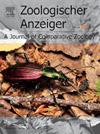进化到入侵:利用几何形态计量学评估南极非本地蝇毛蝇翅膀形状的变化
IF 1.5
3区 生物学
Q2 ZOOLOGY
引用次数: 0
摘要
全球化增加了人类的流动,改变了生态系统,并引入了威胁生物多样性的非本地物种,特别是在南极洲。由于其恶劣的气候条件,南极洲在很大程度上受到保护,免受生物入侵。然而,人类活动的增加和环境的变化正在促进外来物种的引入。像maculpentrichocera这样的物种带来的风险是巨大的,因为它们可以在新的环境中适应和生存。这凸显了了解有助于它们成功的适应因素的重要性,以防止未来的入侵和保护非洲大陆独特的生态系统。本研究的目的是量化不同南极基地相关的斑羽羽翼个体的形态变异,并利用形态计量学工具分析这种变异在时空背景下的变化。在南极夏季活动期间(2017/18年至2019/20年和2022/23年),在乔治国王岛的Artigas(乌拉圭)、belingshausen(俄罗斯)、Julio Escudero教授(智利)和King Sejong(韩国)的研究站收集了样本。形态计量学分析揭示了研究地点之间翅膀形状的变化,世宗王个体表现出最显著的差异。此外,观察到翅膀大小的时间变化,2017/18和2018/19年的标本比2019/20和2021/22年的标本平均翅膀更大。这些结果强调了了解促成非本地物种成功的因素对防止未来入侵和保护南极洲独特的生态系统的重要性。本文章由计算机程序翻译,如有差异,请以英文原文为准。
Evolving to invade: Using geometric morphometrics to assess wing shape variation in the Antarctic non-native fly Trichocera maculipennis
Globalization has increased human movement, transforming ecosystems and introducing non-native species that threaten biodiversity, particularly in Antarctica. Due to its harsh climatic conditions, Antarctica has largely remained protected from biological invasions. However, rising human activity and environmental changes are facilitating the introduction of non-native species. The risks posed by species like Trichocera maculipennis are significant, as they can adapt and survive in new environments. This highlights the importance of understanding the adaptive factors that contribute to their success in order to prevent future invasions and protect the continent's unique ecosystem. The aim of this study was to quantify the wing morphological variation of T. maculipennis individuals associated with different Antarctic bases, analyzing this variation within a spatial and temporal context using morphometric tools. Samples were collected during Antarctic summer campaigns (2017/18 to 2019/20 and 2022/23) at the following research stations on King George Island: Artigas (Uruguay), Bellingshausen (Russia), Profesor Julio Escudero (Chile), and King Sejong (Korea). Morphometric analyses revealed changes in wing shape among study sites, with King Sejong individuals showing the most significant differences. Additionally, a temporal shift in wing size was observed, with specimens from 2017/18 and 2018/19 having larger average wings compared to those from 2019/20 and 2021/22. These results emphasize the importance of understanding the factors contributing to the success of non-native species to prevent future invasions and protect the unique ecosystem of Antarctica.
求助全文
通过发布文献求助,成功后即可免费获取论文全文。
去求助
来源期刊

Zoologischer Anzeiger
生物-动物学
CiteScore
2.80
自引率
7.10%
发文量
75
审稿时长
>12 weeks
期刊介绍:
Zoologischer Anzeiger - A Journal of Comparative Zoology is devoted to comparative zoology with a special emphasis on morphology, systematics, biogeography, and evolutionary biology targeting all metazoans, both modern and extinct. We also consider taxonomic submissions addressing a broader systematic and/or evolutionary context. The overall aim of the journal is to contribute to our understanding of the organismic world from an evolutionary perspective.
The journal Zoologischer Anzeiger invites suggestions for special issues. Interested parties may contact one of the editors.
 求助内容:
求助内容: 应助结果提醒方式:
应助结果提醒方式:


